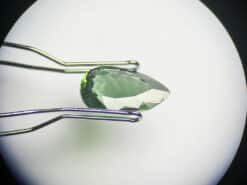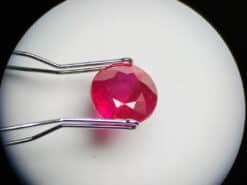Hauyne

Hauyne, hauynite or haüynite is a tectosilicate mineral with sulfate, with endmember formula Na3Ca(Si3Al3)O12(SO4).
Buy natural gemstones in our shop
As much as 5 wt % K2O may be present, and also H2O and Cl. It is a feldspathoid and a member of the sodalite group. The stone was first described in 1807 from samples discovered in Vesuvian lavas in Monte Somma, Italy, and was named in 1807 by Brunn-Neergard for the French crystallographer René Just Haüy (1743–1822). It is sometimes used as a gemstone.
Appearance
It crystallizes in the isometric system forming rare dodecahedral or pseudo-octahedral crystals that may reach 3 cm across; it also occurs as rounded grains. The crystals are transparent to translucent, with a vitreous to greasy luster. The color is usually bright blue, but it can also be white, grey, yellow, green and pink. In thin section the crystals are colorless or pale blue, and the streak is very pale blue to white.
Properties
The stone is isotropic. Truly isotropic minerals have no birefringence, but the stoen is weakly birefringent when it contains inclusions. The refractive index is 1.50. Although this is quite low, similar to that of ordinary window glass, it is the largest value for minerals of the sodalite group. It may show reddish orange to purplish pink fluorescence under longwave ultraviolet light.
Cleavage is distinct to perfect, and twinning is common, as contact, penetration and polysynthetic twins. The fracture is uneven to conchoidal, the mineral is brittle, and it has hardness 5 1⁄2 to 6, almost as hard as feldspar. All the members of the sodalite group have quite low densities, less than that of quartz; hauyne is the densest of them all, but still its specific gravity is only 2.44 to 2.50.
If the gem is placed on a glass slide and treated with nitric acid HNO3, and then the solution is allowed to evaporate slowly, monoclinic needles of gypsum form. This distinguishes hauyne from sodalite, which forms cubic crystals of chlorite under the same conditions. The mineral is not radioactive.
Sample from Mogok, Myanmar
















